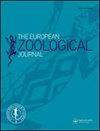Not too big for its mouth: direct evidence of a macrodasyidan gastrotrich preyed in nature by a dileptid ciliate
IF 1.6
4区 生物学
Q2 ZOOLOGY
引用次数: 2
Abstract
Abstract Nearly ubiquitous and usually speciose in most aquatic habitats, the meiofaunal-sized gastrotrichs are recognized as an important component of marine and freshwater ecosystems. The common observations that gastrotrichs feed on bacteria, microalgae and biodetritus strongly imply that they play a relevant role in linking the microbial loop to the higher trophic levels. Which are the organisms that in turn prey on gastrotrichs is, however, a substantially unexplored question. Inspecting meiofauna samples collected from shallow sites of the Tyrrhenian coast, we had the chance to spot a wild case of a macrodasyidan gastrotrich predated by a dileptid ciliate. This case is documented here with a set of in-vivo photos, jointly with an unequivocal taxonomic identification of the preyed gastrotrich with Paraturbanella teissieri and a tentative identification of the predator ciliate with Pseudomonilicaryon marinus.对于它的嘴来说不是太大:大腹蛇在自然界中被二足纤毛虫捕食的直接证据
摘要:小动物大小的胃虫是海洋和淡水生态系统的重要组成部分,在大多数水生栖息地中几乎无处不在,通常是物种。常见的观察结果表明,胃外菌以细菌、微藻和生物碎屑为食,这强烈暗示它们在将微生物循环与更高营养水平联系起来方面发挥了相关作用。然而,哪些生物反过来捕食胃虫是一个基本上未被探索的问题。在检查从第勒尼安海岸浅水区收集的小型动物样本时,我们有机会发现了一种野生的大腹蛇,它的祖先是一种双足纤毛虫。本文用一组活体照片记录了这一病例,并对被捕食的胃richa与Paraturbanella teissieri进行了明确的分类鉴定,并对捕食者纤毛虫与Pseudomonilicaryon marinus进行了初步鉴定。
本文章由计算机程序翻译,如有差异,请以英文原文为准。
求助全文
约1分钟内获得全文
求助全文
来源期刊

European Zoological Journal
Agricultural and Biological Sciences-Animal Science and Zoology
CiteScore
3.10
自引率
5.60%
发文量
80
审稿时长
30 weeks
期刊介绍:
The European Zoological Journal (previously Italian Journal of Zoology) is an open access journal devoted to the study of all aspects of basic, comparative and applied protozoan and animal biology at molecular, cellular, tissue, organ, organismal, population, and community-ecosystem level. Papers covering multiple levels of organization and integrative approaches to study animal form, function, development, ecology, evolution and systematics are welcome. First established in 1930 under the name of Il Bollettino di Zoologia, the journal now has an international focus, reflected through its global editorial board, and wide author and readership.
 求助内容:
求助内容: 应助结果提醒方式:
应助结果提醒方式:


